 |
| Back: Logitech mm50 Middle: Logitech Pure-Fi Anywhere Front: Logitech Pure-Fi Anywhere |
Back: Logitech Audiostation Front: Altec Lansing inMotion Max |
|
| This is by no means a full review of these products - for this you can refer to many excellent sites such as iLounge. I do not attempt to replicate what has already been done - instead this is a personal appraisal based on two extremely important criteria: 1) are these units actually capable of playing music continuously? 2) what is the audio quality really like? I answer both these questions and not from a purely personal perspective either - below you will find a sample recording of the actual sound produced by the inMotion Max. You will notice there are two Logitech Pure-Fi Anywhere speakers - the reason for this is explained in the text. You will also see the Logitech Audiostation - this is not a portable speaker but is included here for referral to sound quality during comparisons. I am not a reviewer - I purchased all the above speakers for my own use and still have them except for the PF-As which I returned to the seller. | ||
| Update: I have recently discovered the Sony RDP-XF100iP - a phenomenal portable iPod speaker which I will shortly be adding to this review. I have also recently owned an Altec Lansing iMT800 Mix BoomBox and will be recounting my experiences with this speaker. Please tune in again soon! |
|
I love music; especially I love listening to music as it comes naturally through the air, free from the entanglement of earbuds and wires - yet while on the move - moving around the house, from room to room and in the garden. For this reason portable iPod speakers are very important. I spent some time researching the iLounge site to help decide what speakers to buy. This is an excellent site with in-depth reviews of a wide range of speakers. Based largely on these reviews I purchased my first portable iPod speaker - the Logitech mm50 - in early 2007. What follows evolved from that early experience. Logitech mm50: Logitech Pure-Fi Anywhere (PF-A): Logitech Portable iPod Speaker Cut-Out Problem Firstly you will notice that there are two PF-As in the above picture. Why you may ask? This is because I approached the retailer about this problem (Gadgetsquare on eBay) and they offered to send me a second unit to check out, before returning the first one. I thought this was unusually generous and trustworthy. Having checked out the second unit, I found it was identical to the first one - in all respects - not only did it cut out in exactly the same way, on both mains and battery power, but the other defects of the PF-A (more on this below) were also identical. The mm50 has an exactly similar cutting out problem. Thus I have personally witnessed three separate Logitech portable speaker products, all with an identical cutting out problem. Does it stop there? No, after considerable research, I believe this cutting out problem may exist across all Logitech portable (battery powered) speaker products - not only the mm50 and PF-A but also the 'Express' variants - there is certainly ample evidence of this in the Logitech forums. Indeed it would be unusual if they did not use a standardised firmware design across a range of similar products, because it saves money - the same reason why car manufacturers use the same engine in different models, and so on. So what is the cause of this persistent cutting out? I have no proof but based on three decades of electronics experience and two decades of firmware and software design experience I believe this problem is due to deliberate firmware design to extend battery life. What happens is this: while in battery mode, the DSP firmware constantly monitors the incoming audio level and cuts out (puts the speaker into sleep mode) if the audio level remains below a certain threshold for a defined time of between 90 seconds and 2 minutes. This behaviour will most certainly save battery life and is undoubtedly a marketing-inspired move to enable Logitech to claim "10 hours battery life..". However an obvious issue seems to have escaped Logitech: this design will have a major impact for the many people who listen to music with long quiet periods of which there are many genres including classical, 'soul' music, spiritual music, pipe music and so on. In these circumstances the unit can cut out so regularly as to be unusable. Fortunately for Logitech the majority of their customers probably listen to rock music or pop music, or music that has any kind of regular beat or 'thump' - this maintains the threshold above the critical level, and the unit remains playing. Thus the majority of people who listen to rock music or pop music may never witness the problem. Whatever the impact on any particular audience, this is a deeply flawed
method of battery saving because music is an emotional experience. I
don't know of any composer who deliberately put stops into their music
- points at which the music arbitrarily stops dead for indefinite periods.
Yet Logitech deliberately impose this upon listeners in the interest
of marketing. Of course, a music player should NEVER cut out unless: That this is a huge problem can be seen from the Logitech forum, including
especially this
thread, one of the longest threads on the entire forum which deals
exclusively with the PF-A cutting out problem. What is a reviewer for, unless it will reveal massively debilitating defects in a product? I choose my words with care - music is an emotional experience - it is composed such that it be listened to without interruption from beginning to end - but when a system sold for the purpose of reproducing that music decides that it shall corrupt the musical experience by stopping dead every 2 minutes or so then it is indeed a massively debilitating defect. Some reviewers such as iLounge merely quote Logitech's blurb of "10 hours battery life". Surely a reviewer should test the product in some way? If they had done so they would have discovered that a battery life of "10 hours", even if true, is meaningless when the unit repeatedly stops dead every 2 minutes or so. The "Logitech Nervous Tic"': The way forward: In the past I have come to associate the name Altec Lansing with professionally designed audio equipment. I noticed they had introduced a new portable speaker called the inMotion Max which looked very interesting. I noticed that iLounge were less than enthusiastic about this speaker and gave it only a 'B' rating as opposed to an 'A' for the PF-A. In the light of my experience with PF-A I took this to be a recommendation for the Max - in order to get a really good, properly designed and functioning speaker it was clear that I had to go against the iLounge rating. Enter the inMotion Max!... |
Altec Lansing inMotion Max
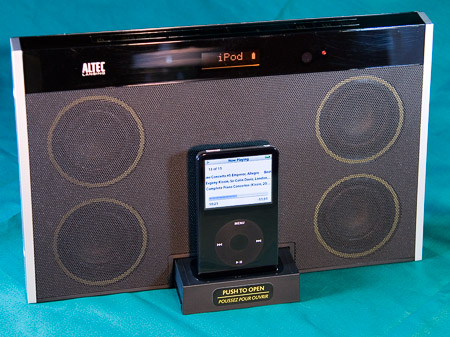 |
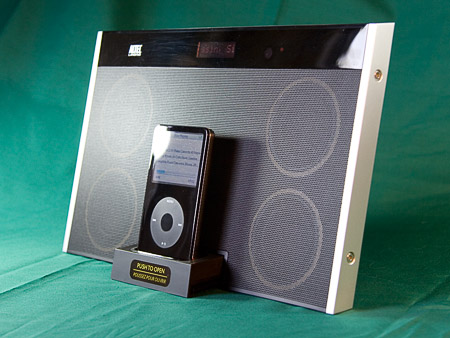 |
|
Sound quality: First of all this speaker
has hugely impressive sound. It has rich and detailed
sound right through the treble, the mid frequencies, and to the bass
which growls, shudders, and thuds to an amazing degree considering
the size of the enclosure. My first listening experience with this
speaker was part of Symphonie Fantastique (Berlioz) - the speaker
was placed on a large table about 4 feet from me - I was amazed at
how the drum beats seemed to 'explode' from the front of the Max -
the table was vibrating and I even felt the vibrations in my rib cage.
I had never heard anything like this from a portable iPod speaker.
Pressure from the lowest bass notes cannot be generated with such
a small speaker but after comparison with my Hi-Fi system (B&W
DM-4 speakers) I can confidently say that all of the sounds are audible
- what's missing is low frequency pressure, some definition and clarity
in the mid/upper registers, and of course stereo separation which
can never equal that of a separate stereo speakers. |
|
 |
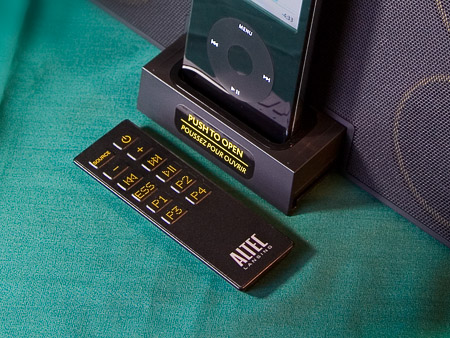 |
|
Aesthetics: Aesthetics is a personal
thing however I mention it only because of iLounge's remarkable stance.
At the very top of their report they state: "We're going to come
right out and say it: Altec Lansing's inMotion MAX ($200) is not what
we'd call an attractive portable speaker system." Yet in the
review itself they state: "..MAX manages to present even more
of the sound spectrum, offering noticeably more bass and a little
extra detail in both the treble and mid frequencies. Music sounds
as full-bodied as is possible in the absence of a dedicated subwoofer,
and we actually enjoyed listening to any track we played through MAX’s
speakers.." So on audio quality, the most important criteria
of all, they rate it very highly, higher then the PF-A. Yet the overall
rating is "B" compared to "A" for the PF-A...
Why? The only possible conclusion is that they down-rated the Max
because they don't like the look of it! As I mention in the opener,
aesthetics is a purely personal thing - it can certainly be commented
on, but should never form part of a rating, simply because
people will have different views and it has no effect on product performance. |
|
 |
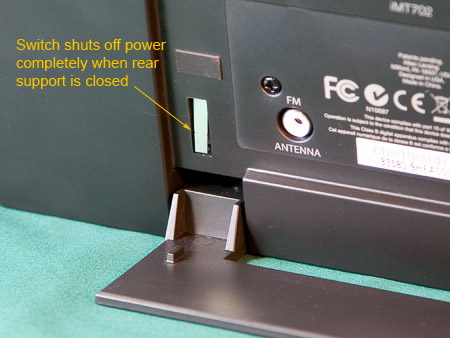 |
|
The rear panel has connectors
for power, Aux (line-in audio), FM antenna, and a slot for storing the
remote control when not in use. A very nice feature is a switch that
shuts off power completely when the rear support is closed, as it will
be whenever the Max is transported. It means the Max cannot be accidentally
turned on and the battery will not drain.
FM Radio: The tuner performs very well, producing virtually no audible static on reception from a 250KW BBC FM transmitter 53 miles away using only the supplied wire dipole. FM music sounds very good, though speech exhibits some colouration, sounding a little 'boxy' with some apparent depression in mid frequencies, though it remains perfectly audible. Stepping through frequencies using the remote control sometimes needs a double press for each change, making it a bit laborious, though saving and recalling stations through the P1-P4 keys is very clean and accurate. |
|
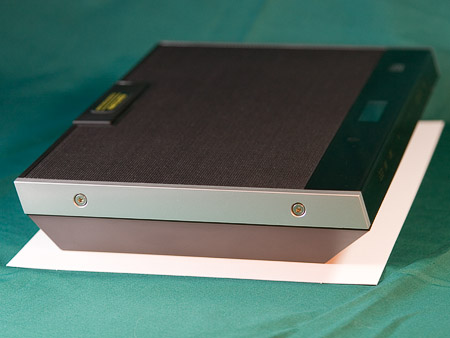 |
 |
|
Portability: The Max is fairly easy
to carry around but considering it is sold as a portable they could
have made it a bit easier. Ideally it should have either a slot or
a small fold-away carrying handle on the rear panel. As iLounge notes,
it is easy to accidentally activate the touch-sensitive buttons when
carried in this way. But I am not sure pressure sensitive buttons
are the best answer. A handle is all that's required - the touch sensitive
buttons are quite nice to use. Turning it off (quick touch on the
power button) will stop the buttons from being accidentally activated. |
|
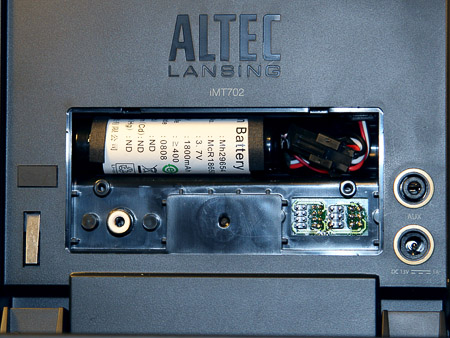 |
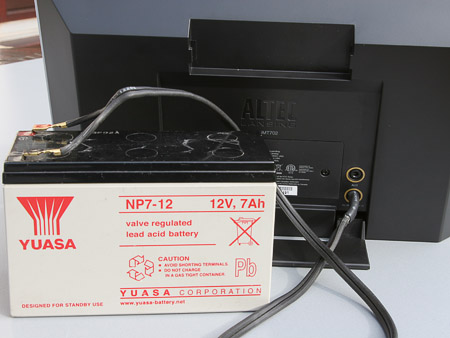 |
|
|
Recorded sound from inMotion Max:
|
Here you can listen to the actual sound of the Max, recorded by an
Olympus LS-10 Digital PCM Recorder. The Max was placed on a bookshelf
in a small but acoustically 'dead' room. There are bookshelves stacked
with books up to the ceiling on three sides and a large curtain on the
fourth. The Olympus LS-10 was on a tripod four feet from the Max, with
its volume on 28 (70%). The mic sensitivity was set to low to minimise
room pick up, but even so I think the room reverb is low. |
|
Three quite different pieces are selected to try to illustrate the
quality (and defects): |
Compared to...
|
Audiostation: I never though it would
be possible to compare a portable, battery powered iPod player to the
Logitech Audiostation. But the Max compares very well even though the
Audiostation (see title picture) is in a different category, being a
heavy (4 Kg) mains powered unit with long throw 4" drivers that
need a brick sized PSU delivering 2 Amps to power them. I compared the
two side by side with the Audiostation volume around 75% and the Max
volume on 80% (level 32) such that the volume from the two units sounded
the same. I listened to an extract from Berlioz Te Deum with full orchestra,
organ, and a large chorus. The Audiostation gave an impressive and full
bodied sound with more power in the bass as one might expect, though
the bass is perhaps overly DSP-enhanced, giving it a 'boom box' sound.
The Max sounded very similar, delivering all of the bass sounds of the
Audiostation, including low organ growls, but with less testosterone
and I feel, more accuracy. The Max sound felt more spacious with a little
more definition and clarity in both the middle and top registers. I
could not detect any real distortion from either unit. As an aside,
I have no problems with the Audiostation - it delivers a very full sound
and, being mains powered, has none of the quirks and defects of the
PF-A, and seems good value for money. |
Anomalies, quirks, and defects
|
Logitech mm50: |
|
Logitech Pure-Fi Anywhere (applies to both
PF-As): |
|
inMotion Max: |
|
Finally... I have no connection at all
to Logitech, or to Altec Lansing, or indeed to any other company involved
in audio products. I work as a business manager in telecommunications
software and my main hobby is astronomy.
As mentioned at the beginning, I love music but have no connection with
any company involved in music. My reason for putting together this assessment
was largely the result of my astonishment at the difficulty in finding
a portable iPod player that sounded good and was capable of playing
music with some degree of integrity - two very simple demands you may
feel - however it took 2 years, copious research, and the purchase of
4 separate products before I finally found one that fulfilled this modest
expectation. There should have been no difficulty at all if only some
reviewers would stop their obsession with useless personal views on
'aesthetics' and substituted that valuable space with information that
might substantially affect actual use of a product! |